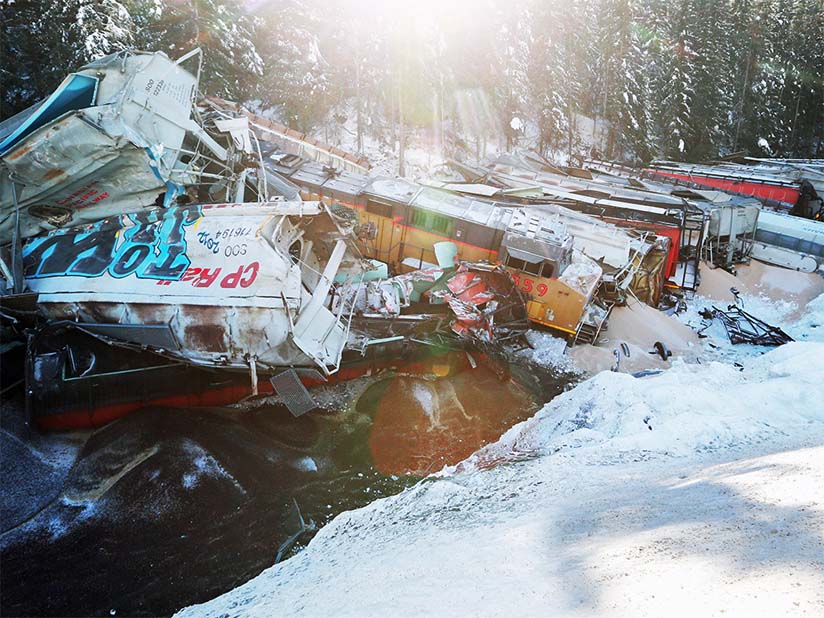
Calgary Alberta - Canadian Pacific (CP) will upgrade testing of train brakes on grain cars following a derailment that killed three
workers and in light of research showing defects in the process, the company said Wednesday.
On Tuesday, the Transportation Safety Board (TSB) released details of a study begun in 2015 involving Transport Canada (TC), the National Research Council
(NRC), and CP that showed the current manual testing of brakes, known as No. 1 Air Brake Test, was unreliable in cold weather on grain cars.
It found the Automated Train Brake Effectiveness (ATBE) process to be 139 times more likely to detect faulty brakes than the No. 1 test that was used to green
light a 112 car westbound train that later suffered a brake failure, sending it careening down a steep slope and through the upper Spiral Tunnel near Field on
4 Feb 2019.
Ninety-nine of the cars and two locomotives on train 301-349 derailed, killing conductor Dylan Paradis, engineer Andrew Dockrell, and trainee Daniel
Waldenberger-Bulmer.
Cold temperatures are known to impair the effectiveness of train air brakes.
On Wednesday, a spokeswoman for CP said the company was moving ahead with expanding the use of ATBE, which it has already employed for trains moving potash
and sulphur.
"CP has been in discussions with TC throughout and is anticipating that it will be ready to file its submission for the adoption of the ATBE technology
for its grain fleet later this year," Salem Woodrow said in a statement.
"Since the release of the NRC study, CP has, continues to gather, and study additional data and test different algorithms in order to further expand the
use of ATBE to its grain fleet."
She wouldn't comment on whether the use of the ATBE system might have prevented the 2019 derailment or other accidents.
In its safety advisory regarding that accident and the brake testing research, the TSB said crews had issued "multiple" hazard notifications
regarding braking problems on Field Hill before February 2019.
CP and TC didn't respond to an inquiry about how many such notifications had been made by crews, who raised the alarm about train 301-349's brakes leading to
an emergency stop just before the tragedy.
TSB officials in its advisory asked TC, "what action, if any, will be taken" on the issue of unreliable brake testing, with TSB spokesman Alexandre
Fournier telling Postmedia they believe "urgent action is required."
TC spokeswoman Frederica Dupuis said the ministry is reviewing the TSB advisory, adding "we will not hesitate to take action to further protect the safety
of the rail system."
But an academic who studied the fiery disaster at Lake Megantic, where a runaway train carrying oil destroyed the centre of the town and killed 47 people on
6 Jul 2013, said TC and CP have been slow to act on improving brake testing.
"They've known of the problems for four to five years," said Bruce Campbell, author of the book "The Lake Megantic Rail Disaster: Public
Betrayal, Justice Denied".
"It's not been reliable, it's not a good test, and yet they're playing the odds."
TC, he said, has been overly deferential to railway companies.
A TSB safety advisory letter sent to TC in April 2019 said an examination after the accident of the 13 cars of train 301-349 that didn't derail, using a
specialized testing device, revealed the air brakes on all of them were faulty.
"As the 13 grain hopper cars represent about 11 percent of the 112 cars on the occurrence train, the test results generally represent the air brake
performance on train 301-349 as it operated at the time of the occurrence," states the letter.
Bill Kaufmann.
In 2011, Canadian Pacific (CP) implemented a new Automated Train Brake Effectiveness (ATBE) process for coal trains which replaces the visual
Class 1 (No. 1 Air Brake Test) required under Canada's Transport Canada (TC) regulations.
The ATBE process relies on Wayside Detector technology to assess the operation of brakes on each rail car under dynamic conditions.
CP began analyzing wayside detector information in 2008 as the basis for evaluating the braking performance of coal trains in Canadian Export service,
specifically targeting existing Hot Box and Hot Wheel Detectors strategically situated alongside the track.
Using the wayside detector output, the new ATBE process improves upon the visual No. 1 Brake Test by evaluating brake effectiveness.
The wayside detector information is automatically transmitted to a central Equipment Health Monitoring System after each train passing, where train brake
effectiveness is evaluated and results published to mechanical maintenance facilities and train crews.
The published results constitute the completed ATBE Test for the train.
Given the substantial number of mechanical components requiring visual inspection each day by railway train inspectors, and taking into account the
considerable investment CP has made into Wayside Detection technology, focus has moved towards Technology Driven Train Inspections (TDTI), preferring
predictive, proactive, maintenance practices, and condition-based maintenance policies instead of the traditional reactive maintenance approach.
 In very
simple terms... wayside detectors measure the temperature of rail car wheels during a descent with brakes applied. Heating is normal so cold wheels indicate
the car's brake system isn't functioning correctly.
In very
simple terms... wayside detectors measure the temperature of rail car wheels during a descent with brakes applied. Heating is normal so cold wheels indicate
the car's brake system isn't functioning correctly.
provisions in Section 29 of the Canadian
Copyright Modernization Act.

